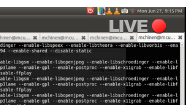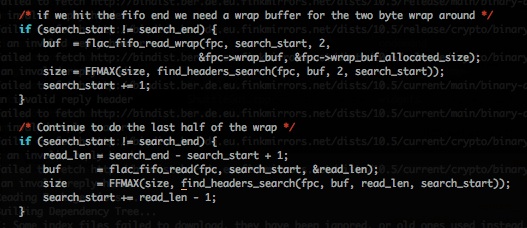27
Jun 11
21:16
Justin.tv desktop streaming in linux
There are really no good tutorials for this that I could find, so here’s a tutorial on how to get justin.tv up on ubuntu. This should work with other linux distros. Before you start calculating the millions you’ll be making from ad revenue, lets first get you working with a stream. Then you can broadcast your sick rts skills or live coding sessions, as you see fit and rake in the dough.
http://apiwiki.justin.tv/mediawiki/index.php/Linux_Broadcasting_API
is the main site for how to do this, but it isn’t very detailed and doesn’t go over desktop streaming.
We’re going to use ffmpeg to stream the desktop and capture our audio as well.
1. First you need a justin.tv account, so go create one.
2.Then go to this page (while logged in) and click the ‘show’ link to view your stream key. This is sort of like a password, so don’t give it out.
3. Install ffmpeg if you don’t have it (you probably do,) but if you don’t for debian/ubuntu it’s the following:
sudo apt-get install ffmpeg libavcodec-extra-52
4.Start the stream.
INRES="1920x1080" # input resolution OUTRES="1024x576" FPS="20" # target FPS QUAL="fast" # one of the many FFMPEG preset STREAM_KEY=live_231xxxxxxxxx #get your stream key as described above.
Then run ffmpeg with
ffmpeg -f x11grab -s "$INRES" -r "$FPS" -i :0.0 -f alsa -ac 2 -i hw:0,0 -vol 4096 -vcodec libx264 -vpre "$QUAL" -s "$OUTRES" -acodec libmp3lame -ab 128k -threads 0 -f flv "rtmp://live.justin.tv/app/$STREAM_KEY flashver=FMLE/3.0\20(compatible;\20FMSc/1.0)"
I modified this command from a forum post that used the one below. My changes were to not use pulseaudio and to boost the volume to twice as much (256 is default, so adjust accordingly)
some people had success with pulseaudio, but my ubuntu/wine config must not be setup to use it.
If audio fails, try this command instead.
ffmpeg -f x11grab -s "$INRES" -r "$FPS" -i :0.0 -f alsa -ac 2 -i hw:0,0 -vcodec libx264 -vpre "$QUAL" -s "$OUTRES" -acodec libmp3lame -ab 96k -vol 4096 -ar 22050 -threads 0 -f flv "rtmp://live.justin.tv/app/$STREAM_KEY flashver=FMLE/3.0\20(compatible;\20FMSc/1.0)"
The above command uses your audio output (what comes out of your speakers) as the audio to be streamed. To record from a mic, you can use pulse (I think it is installed by default):
ffmpeg -f x11grab -s "$INRES" -r "$FPS" -i :0.0 -f alsa -ac 2 -i pulse -vcodec libx264 -vpre "$QUAL" -s "$OUTRES" -acodec libmp3lame -ab 96k -vol 4096 -ar 22050 -threads 0 -f flv "rtmp://live.justin.tv/app/$STREAM_KEY flashver=FMLE/3.0\20(compatible;\20FMSc/1.0)"
This command should start your stream on justin.tv.
I am not sure why my audio is 1/16th what it should be and I need to scale the volume that much.
Next tutorial will be about how to integrate a webcam into a desktop streaming setup.
Update: I installed the pulse audio device/volume selector, and then ran the second command which uses pulse. While the stream is open I need to change from duplex stereo to output analog only, then change back. It’s weird that this fixes the filtering/low volume issue, but it does get around it. I only needed to make the swap once and it all works great.
sudo apt-get install padevchooser
I have recently switched to youtube because justin.tv/twitch tv doesn’t support saving or transfering videos to youtube if the content is not games. So while I may still use twitch for starcraft 2 and live streaming, I now use the following very similar command to record to mp4, then upload. I find I get much better framerates like this.
This command records the file to my videos folder with a timestamp attached. It wouldn’t take much more work to automate this upload process.
ffmpeg -f x11grab -s "$INRES" -r "$FPS" -i :0.0 -f alsa -ac 2 -i pulse -vcodec libx264 -vpre "$QUAL" -s "$OUTRES" -acodec libmp3lame -ab 96k -vol 4096 -ar 22050 -threads 0 "$HOME/Videos/JLPTN1/cast720-$(date +%Y_%m_%d_%k_%M).mp4"
For some reason I needed $HOME instead of ~ to get the filepath to work.
Update2: I recently installed FFmpeg 0.8.10 which uses libavcodec 53.8.0, and this works for the mp4 capture, but fails silently with the rtmp output to justin.tv not going anywhere (Even after I take out the no longer valid -vpre and flashver=FMLE/3.0\20(compatible;\20FMSc/1.0) – if you leave the flashver in you get an error that says [rtmp @ 0x9be5fc0] Server error: Authentication Failed.
. My solution was to have two versions of ffmpeg – one compiled from source in /usr/local/bin/ and one using the safe libavcodec 52.72.2 – this is the one that apt-get gave me in /usr/bin/, and whenever I need justin.tv I use the older one.



